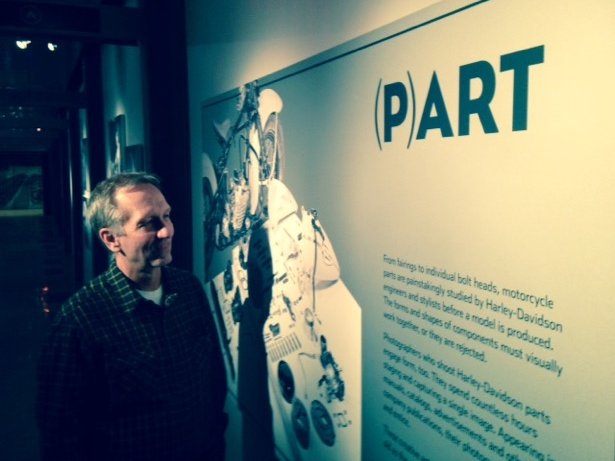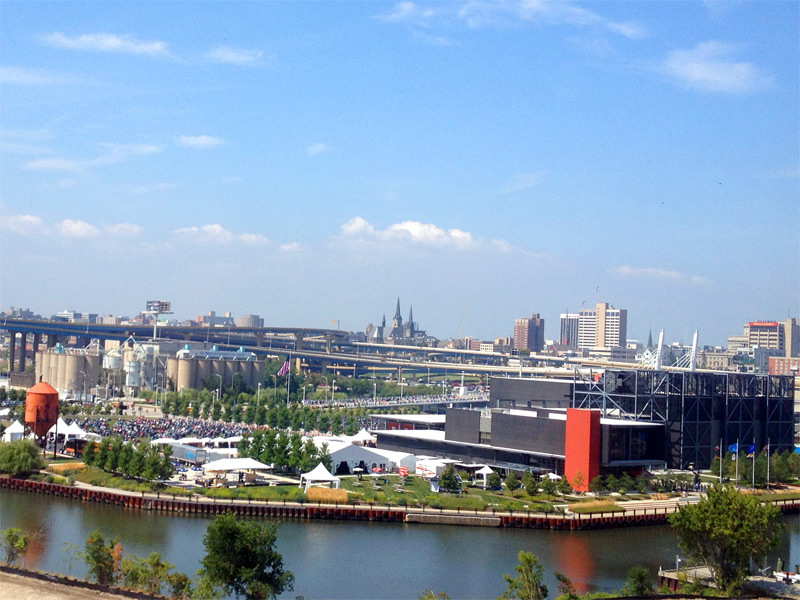For someone not fitting the typical Harley guy stereotype, Milwaukee’s Jim Fricke is one of the Motor Company’s most authentic and inspirational brand representatives.
As curatorial director of the Harley-Davidson Museum since 2004, Fricke works with a cool and quiet confidence developing the museum’s unique design, exhibits, events and music playlists. While Fricke often defers the bright Harley media spotlight to others, he is as passionate and knowledgeable as anyone on Harley legend and lore.
Prior to joining Harley-Davidson, Fricke spent 12 years helping lead the Experience Music Project (EMP) contemporary pop culture museum in Seattle, which included authoring an acclaimed book on the beginnings of the New York hip-hop culture in the 1970s.
Born and raised on the West Coast and a former professional musician, Fricke brings a refreshing perspective to his job at the museum and to the cultural scene in Milwaukee.
OnMilwaukee.com recently took a ride with Fricke as he discussed the Harley-Davidson Museum’s mission, local arts and culture, and his musical influences and preferences.
OnMilwaukee.com: You have an extremely cool job, but what are some little things that make it cool?
Jim Fricke: As curator, it’s like being an investigative journalist where you have the opportunity to move from one subject to another. With exhibits, you become an expert in something that you maybe only have a cursory knowledge of and then move on to the next thing.
Since it’s such a short walk for me right into the museum, the most consistently rejuvenating experience is going in and talking to people. Sometimes, you really get to make somebody’s day.
OMC: How often do people tell you that your job is cool?
JF: I get it a lot. I don’t necessarily fit the Harley guy mold. I don’t always wear the MotorClothes and can just walk up to people in the museum. I’ll start talking to them, and they think, "Who’s this guy?" Then, they get that I know what I’m talking about. At EMP, there was an undertone of, "This kind of sucks because I should have your job, so how come you got it?" Here, that’s what they say about Bill Rodencal. He’s the guy who works on the bikes. For Harley enthusiasts, that’s a cooler job than sitting at a desk.
OMC: Are there any challenges or downsides to such a cool job?
JF: Having spent so much time playing in bands prepared me for this work. I’m honored to work with people who are really passionate, smart and creative with strong opinions. Bringing it all together to make something happen is often a highly emotional operation. One of biggest challenges here is that pretty much everybody you talk to, if they haven’t been here, they are pretty sure they know what it looks like. They come here, and they had no idea it was going to be this cool. But that preconception can be a barrier. I really want to quit surprising people.
OMC: How did the job at EMP in Seattle prepare you for the Harley Museum?
JF: I would not have gotten this job if I hadn’t done that. Things like this don’t happen very often, and I’ve got to do it twice, which is great. They decided to hire me because I had been through a process that is complicated and often stressed. Dealing with important stories, big money, negotiations and doing something that’s making the people who are powerfully influenced by the subject matter proud.
Willie G. (Davidson) was my last interview, and he was highly skeptical. We had a good conversation that ended with him saying, "I pictured somebody with more gasoline in their veins." But as I talked to him, the subject matter was similar to exhibits I did on punk rock. If you love punk rock and consider yourself part of that culture, then your life revolves around that music and lifestyle, and you define yourself by that. People define themselves around not just the motorcycle, but all the things that surround it.
OMC: What are your impressions of Milwaukee?
JF: Before I came here, I honestly didn’t know Harley was in Milwaukee. Like most people, I knew "Laverne & Shirley." When I wandered around, it felt like Seattle in the mid-'80s, but for different reasons. It’s kind of like Seattle, but the buildings are cooler. The oldest buildings in Seattle are from the turn of 20th century. On the West Coast, we couldn’t dream of a brick house because everything is wood. The architecture here is beautiful, and so are the people. We love Seattle, and I always thought that people there were friendly, but not like here.
OMC: What about Milwaukee as it relates to the music scene?
JF: I’m convinced that the Pabst Theater is the most gorgeous place to hear music in the country. And then I discovered the Riverside. I made my living as a performing musician for a long time, but we didn’t go out much because we were always performing or rehearsing. I’ve been delinquent in going out and seeing local bands here.
OMC: Did you know any of the legendary Seattle bands?
JF: I never saw the big Seattle bands. In retrospect, it’s stupid. It seemed like I always ended up leaving just before Pearl Jam played.
OMC: What’s the best way to experience music?
JF: Great live music is best. Some people have truly transcending experiences riding motorcycles, and some do hearing live music and then it makes sense on record. I enjoy CDs and MPs for convenience, but records are best. I grew up with them.
OMC: What’s your favorite biker song or movie?
JF: I have a great memory of going to Sunset Drive-in and seeing "Easy Rider." That was an event because I was a little too young and it was kind of sexy. I’ve made a couple really long playlists for our staff here that are not the typical biker songs. Like Bo Diddley’s "I’m a Road Runner" or Richard Thompson "I Ride in Your Slipsteam."
OMC: What do you think of other museums in Milwaukee?
JF: I love the Calatrava and Saarinen's War Memorial. Having them right next to one another on the lakefront is just crazy cool. My wife works at the public museum, so of course I love that. It’s a great museum in the sense of a place that has been around long enough to create an important legacy and develop incredible collections. I knew about it when I first started getting involved in museums; there were pamphlets and books about it with the old school dioramas. I love the Kohler Art Center in Sheboygan.
OMC: Are other museums competitors or partners when it comes to tourism?
JF: On a certain level, I guess we compete, but really, more is better. People want to go spend their vacation dollars in a place where you have this lovely art museum and public museum with great collections, and Harley-Davidson Museum and Miller Brewery tour. All of those things together make the attraction.
The public museum is really close. In urban setting, there are psychological barriers that cause you to forget about walking from here to there. We tend do big exhibits in summer; they do their big stuff in spring. In fall, there should be some way to work together to make things happen. We’ve done some member swaps and other things.
OMC: What are two things you would change about Milwaukee if you could?
JF: Coming from West Coast culture, the segregation here is hard to take. In many cities, you have the urban suburban divide, and in some ways it’s human nature to be at odds rather than together. Every issue seems so polarized at this point.
I’m a sports fan and recognize that people pay too much attention and spend too much money on professional sports, but the teams have a real impact. It’s a stadium where people from all over the region go see the Bucks. It’s not a city phenomenon. People need to get past their divisions and come together and support something. There is polarization around the streetcar idea. I’ve seen in place like Portland and Seattle where having real public transportation is a reason that those cities are thriving and young people are going to places where they don’t have to own a car. Healthy cities work together to make stuff happen.
OMC: What’s the future for the museum?
JF: I’m genuinely excited about the Willie G. show this summer. It’s the right thing to do for a bunch of reasons, but we’re really doing it right. There’s interesting motorcycle content, but also things that interest the general public. It’s a real insight into what makes this guy tick, who really kind of redefined what motorcycles looks like. I don’t know of anyone who led the design of an iconic design brand for almost 50 years.
We’re telling the first 100 years in part of the museum, but lots has happened since the 100th Anniversary. There’s continuing change. We have a three-year exhibit plan. I can’t tell you what it is, but it’s exciting.
OMC: Do you have a favorite exhibit?
JF: It’s a cop out, but you’re always most excited about what you’re currently working on. Everyone has a different thing. The boxes from our "Worn to be Wild" exhibit that just came off the road. I liked talking Jean Paul Gaultier into loaning us outfits and getting to interview him was great fun. That felt like a really interesting stretch. It went to six different museums and was really successful everywhere, so we’re really proud of that.
OMC: What Harleys do your ride or what’s your favorite bike?
JF: I bought a Wide Glide. Most people know the one with the flames on the tank, but I bought the black one.
Mike Morgan rides retro, whether on his 1976 Harley Aermacchi 250 or Heritage Softail. Mike has been a motorcyclist since 2001 having ridden in Sturgis, Daytona Beach, the California coast, New England and everywhere in between, including in the last three Milwaukee Harley Anniversary parades.
Mike worked in communications and marketing at Harley-Davidson for more than 12 years, writing and editing all kinds of content, including award-winning media kids in 2009 and 2012. He had ridden the Harley several times before Brewer games at Miller Park, and ran in one of the last sausage races at the old County Stadium when he was Communications Manager for the Stadium District Board.







